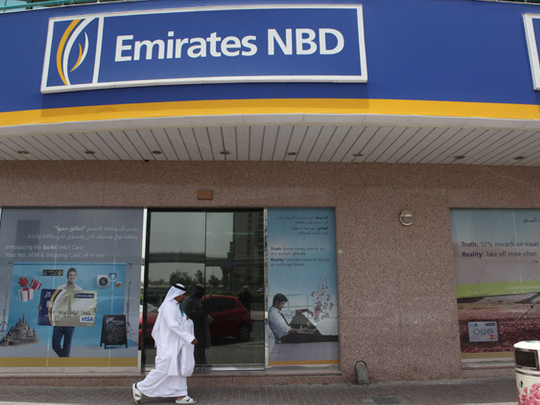
Dubai
Emirates NBD, the UAE’s biggest lender by assets, on Thursday reported a 3 per cent growth in its annual net profit to Dh2.56 billion in 2012, compared to Dh2.5 billion recorded in 2011.
Its total income also rose 3 per cent to Dh10.2 billion while operating profit before impairments rose by 2 per cent to Dh6.5 billion from 2011.
Its total assets increased by 8 per cent at Dh308.3 billion at the end of 2012 compared with Dh284.6 billion at the end of 2011, it said in a release today.
The company declared cash dividend of 25 per cent per share.
“Despite the challenges reflected in the broader global economic environment, the UAE and Dubai in particular have shown resilience and solid growth during the year and Emirates NBD is well-placed to continue to capitalise on this improving economic backdrop,” Shaikh Ahmad Bin Saeed Al Maktoum, Chairman of Emirates NBD said in a statement.
“These financial results reflect a very positive operational performance and demonstrate the strength of Emirates NBD and its position as a leading bank in the region.”
The bank’s total costs for the year ended 31 December 2012 increased 5 per cent to Dh3.66 billion, resulting from the consolidation of Dubai Bank costs from Q4 2011.
Excluding the impact of Dubai Bank, operating costs improved by 1 per cent in 2012 due to cost optimisation initiatives.
Net interest income for the year declined 5 per cent to Dh6.91 billion from Dh7.25 billion in 2011. Net impairment loss on financial assets of Dh4 billion, improved by 20 per cent compared with 2011.
The bank’s results have beaten analyst’s expectations. “ENBD’s results beat our expectations by a wide margin on lower provisions and higher top-line movement, though non-interest income underperformed our expectations,” says Naveed Ahmad, Senior Financial Analyst at Global Investment House.
“The quarterly improvement in the bank’s asset quality is a good omen; especially since we had envisioned it to touch 14.8 per cent by the close of the year. The non-performing loans ratio though deteriorated from 2011 levels, it was well within the guidance provided by the bank earlier. The bank’s bottom-line if adjusted for the one-off gains made in 2011 grew by a massive 2.6x in 2012.”
Customer loans increased by 7 per cent to Dh218.2 billion, compared to Dh203.1 billion at the end of 2011 while customer deposits grew 11 per cent to Dh213.9 billion compared to Dh193.3 billion at the previous year-end.
Headline loan to deposit ratio improved to 102 per cent from 105 per cent at the end of 2011 while the bank’s capital adequacy ratio at extremely healthy level of 20.6 per cent, the bank said.
Non-interest income recorded an improvement of 24 per cent to Dh3.3 billion for 2012, driven principally by higher investment securities income and lower write-downs on investment properties.
“Excluding these impacts, core fee income improved by 9 per cent resulting from increased banking fee income and a pickup in trade finance activity,” the statement said.
Emirates NBD last year completed the integration of Dubai Bank that cost it Dh49 million. However, it raised Dh14.9 billion medium term debt issuance.
Rick Pudner, Chief Executive Officer of Emirates NBD, said, his bank may not need to raise debts this year, when Dh4.4 billion worth of debt matures. “However, if we find attractive deals, then we might reconsider looking at raising debts,” he said in a conference call.
“Overall, the outlook is positive and Emirates NBD is well placed to meet liquidity requirements this year.”
Emirates NBD’s Chief Financial Officer, Surya Subramanian, however, said that the bank might roll-over part of its debts this year, without giving details.
The bank maintained Dh30.8 billion liquid assets at the end of 2012, which is 11 per cent of its total liabilities.
Credit rating agency Standard and Poor’s has identified credit risk as one of the main risks for the UAE banking sector in its report issued in November.
“Lending and underwriting standards for the country’s banks are improving, but remain relaxed,” it said. “Similar to most other GCC markets, UAE banks’ lending is highly concentrated on cyclical or vulnerable sectors like real estate and construction.
“There is also a fair amount of restructured/renegotiated lending exposures in the market, and a potential nonperformance of these exposures could create additional provisioning pressures on certain banks.”











